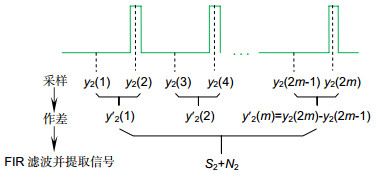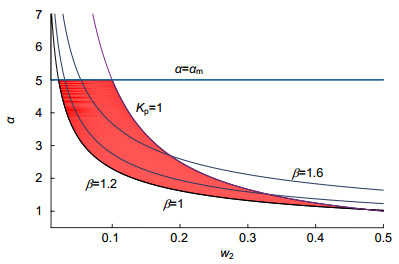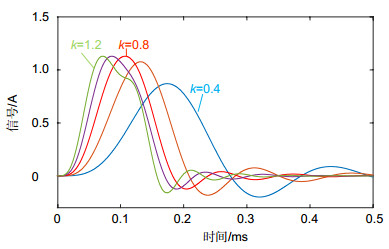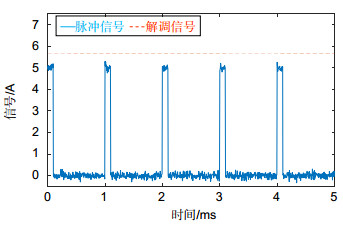The establishment and analysis of noise model for pulse modulation dimming method and square-wave modulation dimming method
-
摘要
在利用紫外荧光法对油含量小于10 mg/L的油田回注水进行检测时,光源热功率过大会降低测量结果的精度。为减小光源热功率,提出了光源的脉冲调光方法(占空比小于50%),替代原有的方波调光方法(占空比为50%)。分别建立了基于脉冲调光方法与方波调光方法的噪声分析模型,比较了两种方法的测量结果信噪比(SNR),并推导了测量结果信噪比与光源功率的关系,在信噪比相同的情况下, 可以得出脉冲调光方法的电流幅值与占空比的最优选择方案。结果表明,当测量结果信噪比相同时,脉冲调光方法光源功率不足方波调光方法的21%。最后通过MATLAB软件对两种调光方法的信号解调过程进行仿真,比较了两种方法的测量结果信噪比,仿真所得信噪比关系与理论推导结果一致。

Abstract
When measuring the oil concentration lower than 10 mg/L in reinjection water based on ultraviolet fluorescence method, high thermal power of the light source will reduce the accuracy of measurement results. To reduce the thermal power of light source, pulse modulation dimming method (duty ratio less than 50%) was proposed to replace square-wave modulation dimming method (duty ratio equal to 50%). Two noise analysis models for pulse modulation and square-wave modulation dimming method were built. Signal-to-noise ratio (SNR) of measurement results for two methods were compared. The relationship between SNR and light source power was derived. The optimum choices of current amplitude and duty ratio for pulse modulation dimming method were proposed under the condition of the same signal-to-noise ratio. Results show that the light source power for pulse modulation dimming method is less than 21% of that for square-wave modulation dimming method under the condition of the same signal-to-noise ratio. Finally, signal demodulation models of two dimming methods were simulated by MATLAB software. The simulated relationship of SNR for two methods is consistent with the theoretical analysis results.
-
Overview

Overview: When using crude oil for producing qualified oil and gas production, we need to separate the water from the crude oil which is called oil sewage. The oil sewage contains a certain amount of oil and other impurities. The oil sewage is usually reinjected back under the ground after multiple processes. To avoid the excess oil of reinjection water affecting the quality of underground water source, it is important to ensure that the oil concentration is lower than requirement. Oil concentration measurement methods include infrared spectrophotometry, nephelometry, ultraviolet spectrophotometry and ultraviolet fluorescence. The ultraviolet fluorescence method has the advantages of real-time and high precision. The oil concentration of purified reinjection water is usually lower than 10 mg/L, so the ultraviolet fluorescence method is more suitable in this situation. To accurately measure the concentration of reinjection water based on ultraviolet fluorescence method, high transmission power of light emitting diode (LED) is required, so that the fluorescence of aromatics in oil is sufficient to be detected. In early experiments, the oil concentration is measured by square-wave dimming method (duty ratio equal to 50%). The chip temperature of LED will be higher than requirement because of the high transmission power of LED, thereby, LED luminous efficiency will be drastically reduced, and LED devices will be even damaged. To solve this problem, this paper proposed the pulse modulation dimmer method (duty ratio less than 50%) to reduce the LED average power and increase instantaneous power, which could ensure high signal-to-noise ratio (SNR). Pulse modulation dimming method makes LED produce higher transient light intensity and shortens the amount of conduction time in unit time. Two noise analysis models for pulse modulation and square-wave modulation dimming method were built. The discussion focused on wideband limiting in square-wave dimming method and the influence of noise aliasing in pulse modulation dimmer method. Signal-to-noise ratio of measurement results for two methods were compared under several condition. The relationship among SNR, light source power and duty ratio was derived. The optimum choices of current amplitude and duty ratio for pulse modulation dimming method were proposed under the condition of the same signal-to-noise ratio. Results show that the light source power for pulse modulation dimming method is less than 21% of that for square-wave modulation dimming method under the condition of the same signal-to-noise ratio. Finally, signal demodulation models of two dimming methods were simulated by MATLAB software. The simulated relationship of SNR for two methods is consistent with the theoretical analysis results.
-

-
表 1 滤波后的脉冲幅值
Table 1. Pulse amplitude after filter
k 0.4 0.6 0.8 1 1.2 1.4 幅值 0.870 1.077 1.129 1.129 1.129 1.129 表 2 电流信号参数
Table 2. Current signal parameter
方波调光 脉冲调光 占空比/% 50 30 20 10 5 信号振幅/A 1 5 5 5 5 载波频率/Hz 1000 1000 1000 1000 1000 表 3 不同占空比下γ与值β
Table 3. Value of γ and β in different duty ratio
w2 5% 10% 20% 30% 40% β 1.542 2.181 3.084 3.777 4.362 γ 1.611 2.315 3.347 3.877 4.65 γ/β 1.044 1.062 1.085 1.026 1.066 -
参考文献
[1] 朱丽娜.油田注水水质劣化因素与处理技术研究[D].大庆: 东北石油大学, 2013.
Zhu L N. Research on the causes of injection water quality deterioration and treatment technology[D]. Daqing: Northeast Petroleum University, 2013.
http://cdmd.cnki.com.cn/Article/CDMD-10220-1013290888.htm [2] 赵友全, 于海波, 何峰.水中油浓度在线检测方法的研究[J].光谱学与光谱分析, 2013, 33(11): 2949-2952. doi: 10.3964/j.issn.1000-0593(2013)11-2949-04
Zhao Y Q, Yu H B, He F. Research on the online detection of oil concentration in water[J]. Spectroscopy and Spectral Analysis, 2013, 33(11): 2949-2952. doi: 10.3964/j.issn.1000-0593(2013)11-2949-04
[3] Wang L R, Yang J H. Measurement of micro oil in water by using ultraviolet fluorescence spectrum technology[C]//Proceedings of the 8th International Conference on Electronic Measurement and Instruments, 2007: 3-556-3-559.
[4] 蔡小虎, 蔡述伟, 程青, 等.红外分光光度法测定地下水中的石油类物质[J].化学分析计量, 2014, 23(4): 14-16. doi: 10.3969/j.issn.1008-6145.2014.04.004
Cai X H, Cai S W, Cheng Q, et al. Determination of petroleum substance in groundwater by infrared spectrophotometry[J]. Chemical Analysis and Meterage, 2014, 23(4): 14-16. doi: 10.3969/j.issn.1008-6145.2014.04.004
[5] 钱贵军, 王学磊, 张小芹.散射透射比值法油分浓度传感器的研究和设计[J].自动化仪表, 2017, 38(2): 86-88, 92. http://d.old.wanfangdata.com.cn/Periodical/zdhyb201702022
Qian G J, Wang X L, Zhang X Q. Research and design of the oil content concentration sensor based on scattering-transmission ratio method[J]. Process Automation Instrumentation, 2017, 38(2): 86-88, 92. http://d.old.wanfangdata.com.cn/Periodical/zdhyb201702022
[6] El Hussein A, Marzouk A. Characterization of petroleum crude oils using laser induced fluorescence[J]. Journal of Petroleum & Environmental Engineering, 2015, 6(5): 1-6. http://www.wanfangdata.com.cn/details/detail.do?_type=perio&id=US20020059020
[7] Sharikova A V, Killinger D K. LIF detection of trace species in water using different UV laser wavelengths[J]. International Journal of High Speed Electronics and Systems, 2007, 17(4): 689-695. doi: 10.1142/S0129156407004898
[8] 李丹.紫外荧光法水中油检测技术和实验的研究[D].天津: 天津大学, 2009.
Li D. Study on the measuring technology and experiments of oil in water using UV fluorometry[D]. Tianjin: Tianjin University, 2009.
http://cdmd.cnki.com.cn/Article/CDMD-10220-1013290888.htm [9] Sharikova A V, Killinger D K. Laser- and UV-LED-Induced fluorescence detection of drinking water and water-dissolved organics[C]//Digital Holography and Three-Dimensional Imaging, 2008.
[10] 赵广立, 冯巍巍, 付龙文.等.基于紫外荧光法检测水中油含量的浸入式传感装置的研究[J].海洋通报, 2014, 33(1): 77-83. http://d.old.wanfangdata.com.cn/Periodical/hytb201401010
Zhao G L, Feng W W, Fu W L, et al. Research on a submersible oil-in-water detection probe based on ultraviolet fluorescence analysis technique[J]. Marine Science Bulletin, 2014, 33(1): 77-83. http://d.old.wanfangdata.com.cn/Periodical/hytb201401010
[11] 许飞.散射和荧光法油田注水在线检测系统研究[D].天津: 天津大学, 2016.
Xu F. Study on the oilfield injection water online detection system using scattering and fluorescence[D]. Tianjin: Tianjin University, 2016.
http://cdmd.cnki.com.cn/Article/CDMD-10056-1017060632.htm [12] 斯容, 卢瑜林, 邓学峰, 等.渭北油田回注水中悬浮物和油含量指标及控制技术[J].油气藏评价与开发, 2016, 6(2): 51-53, 59. doi: 10.3969/j.issn.2095-1426.2016.02.012
Si R, Lu Y L, Deng X F, et al. Content indicators and control technology of suspended solid and oil of reinjection water in Weibei oilfield[J]. Reservoir Evaluation and Development, 2016, 6(2): 51-53, 59. doi: 10.3969/j.issn.2095-1426.2016.02.012
[13] 吴玉香, 尚俊, 王孝洪, 等.一种基于脉冲宽度调制和脉冲幅度调制的发光二极管驱动器[J].光学学报, 2015, 35(9): 0922003. http://www.cnki.com.cn/Article/CJFDTotal-GXXB201509034.htm
Wu Y X, Shang J, Wang X H, et al. A light emitting diode driver based on pulse width modulation and pulse amplitude modulation diming[J]. Acta Optica Sinica, 2015, 35(9): 0922003. http://www.cnki.com.cn/Article/CJFDTotal-GXXB201509034.htm
[14] 梅毅, 陈郁阳, 袁川, 等. LED温度特性的测试[J].照明工程学报, 2007, 18(1): 17-20. doi: 10.3969/j.issn.1004-440X.2007.01.005
Mei Y, Chen Y Y, Yuan C, et al. Measurement of LEDs' temperature characteristics[J]. China Illuminating Engineering Journal, 2007, 18(1): 17-20. doi: 10.3969/j.issn.1004-440X.2007.01.005
[15] 王健, 黄先, 刘丽, 等.温度和电流对白光LED发光效率的影响[J].发光学报, 2008, 29(2): 358-362. http://d.old.wanfangdata.com.cn/Periodical/fgxb200802028
Wang J, Huang X, Liu L, et al. Effect of temperature and current on LED luminous efficiency[J]. Chinese Journal of Luminescence, 2008, 29(2): 358-362. http://d.old.wanfangdata.com.cn/Periodical/fgxb200802028
-
访问统计


 E-mail Alert
E-mail Alert RSS
RSS

 下载:
下载:










